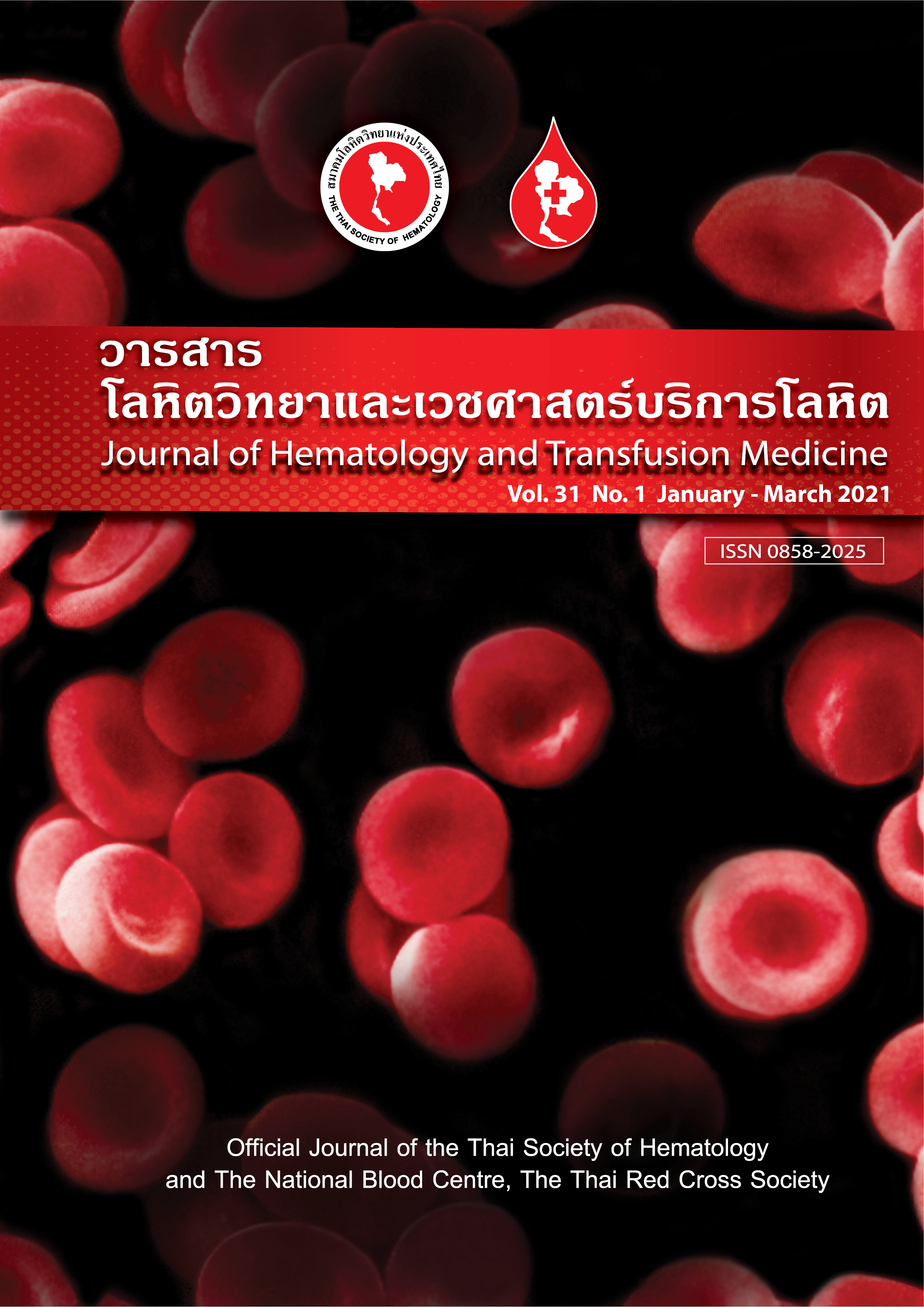Clinical characteristics and outcomes of patients with polycythemia vera in Thailand: a single center study
์No
Keywords:
Polycythemia vera, Myeloproliferative neoplasm, Clinicopathological features, JAK2V617F mutationAbstract
Introduction: The JAK2V617F mutation is the most common mutation among patients with polycythemia vera (PV). This study aimed to determine the clinicopathological profiles and outcomes of Thai patients with PV. Methods: A retrospective analysis was performed of all PV cases diagnosed at our single institute between January 2010 and December 2019. Their age, sex, clinical presentations, laboratory investigations, treatments, and follow-up durations were analyzed. Appropriate statistics were used to analyze the data. Results: Sixty patients received a diagnosis of PV during the study. At diagnosis, median age was 58 (range, 26-85) years (21.7% female). The most common initial clinical findings were erythrocytosis from check-up (43.3%), dizziness (23.3%) and arterial thrombosis (21.7%). Of the 73.3% patients positive for the JAK2V617F mutation, their mean hemoglobin level was 18.28 g/dL (SD 3.08), and hematocrit level was 58.25% (SD 8.95). The median follow-up time was 27.6 months. Sixty percent (n = 35) of the entire patient cohort was treated with phlebotomy, hydroxyurea, and aspirin, either alone or combined. None of the patients transformed to myelofibrosis or myelodysplasia during the follow-up period. We found no association between leukemic transformation and hydroxyurea use. Conclusion: Although the JAK2V617F mutation remains the most common mutation among Thai patients with PV, its prevalence in this study was remarkably lower than those in related reports. Moreover, bleeding was an uncommon initial clinical manifestation among this study cohort.
Downloads
References
References
Arber DA, Orazi A, Hasserjian R, Thiele J, Borowitz MJ, Le Beau MM, et al. The 2016 revision to the World Health Organization classification of myeloid neoplasms and acute leukemia. Blood. 2016;127:2391-405.
Barbui T, Thiele J, Gisslinger H, Kvasnicka HM, Vannucchi AM, Guglielmelli P, et al. The 2016 WHO classification and diagnostic criteria for myeloproliferative neoplasms: document summary and in-depth discussion. Blood Cancer J. 2018;8:15.
Vannucchi AM, Antonioli E, Guglielmelli P, Pardanani A, Tefferi A. Clinical correlates of JAK2V617F presence or allele burden in myeloproliferative neoplasms: a critical reappraisal. Leukemia. 2008;22:1299-307.
Pardanani A, Lasho TL, Finke C, Hanson CA, Tefferi A. Prevalence and clinicopathologic correlates of JAK2 exon 12 mutations in JAK2V617F-negative polycythemia vera. Leukemia. 2007;21:1960-3.
Passamonti F, Rumi E, Pietra D, Elena C, Boveri E, Arcaini L, et al. A prospective study of 338 patients with polycythemia vera: the impact of JAK2 (V617F) allele burden and leukocytosis on fibrotic or leukemic disease transformation and vascular complications. Leukemia. 2010;24:1574-9.
Tefferi A, Lavu S, Mudireddy M, Lasho TL, Finke CM, Gangat N, et al. JAK2 exon 12 mutated polycythemia vera: Mayo-Careggi MPN Alliance study of 33 consecutive cases and comparison with JAK2V617F mutated disease. Am J Hematol. 2018;93:E93-6.
Fallah M, Kharazmi E, Sundquist J, Hemminki K. Higher risk of primary cancers after polycythaemia vera and vice versa. Br J Haematol. 2011;153:283-5.
Tefferi A, Guglielmelli P, Larson DR, Finke C, Wassie EA, Pieri L, et al. Long-term survival and blast transformation in molecularly annotated essential thrombocythemia, polycythemia vera, and myelofibrosis. Blood. 2014;124:2507-13.
Tefferi A, Rumi E, Finazzi G, Gisslinger H, Vannucchi AM, Rodeghiero F, et al. Survival and prognosis among 1,545 patients with contemporary polycythemia vera: an international study. Leukemia. 2013;27:1874-81.
Landolfi R, Marchioli R, Kutti J, Gisslinger H, Tognoni G, et al. Efficacy and safety of low-dose aspirin in polycythemia vera. N Engl J Med. 2004;350:114-24.
Fruchtman SM, Mack K, Kaplan ME, Peterson P, Berk PD, Wasserman LR. From efficacy to safety-a polycythemia Vera study group report on Hydroxyurea in patients with polycythemia Vera. Semin Hematol. 1997;34:17-23.
West WO. Hydroxyurea in the treatment of polycythemia vera: a prospective study of 100 patients over a 20-year period. South Med J. 1987;80:323-7.
Tatarsky I, Sharon R. Management of Polycythemia Vera with Hydroxyurea. Semin Hematol. 1997;34:24-8.
Finazzi G, Caruso V, Marchioli R, Capnist G, Chisesi T, Finelli C, et al. Acute leukemia in polycythemia vera. An analysis of 1,638 patients enrolled in a prospective observational study. Blood. 2005;105:2664-70.
Quintás-Cardama A, Kantarjian H, Manshouri T, Luthra R, Estrov Z, Pierce S, et al. Pegylated interferon alfa-2a yields high rates of hematologic and molecular response in patients with advanced essential thrombocythemia and polycythemia vera. J Clin Oncol. 2009;27:5418-24.
Kiladjian JJ, Cassinat B, Chevret S, Turlure P, Cambier N, Roussel M, et al. Pegylated interferon-alfa-2a induces complete hematologic and molecular responses with low toxicity in polycythemia vera. Blood. 2008;112:3065-72.
Tefferi A, Barbui T. Polycythemia vera and essential thrombocythemia: 2019 update on diagnosis, risk-stratification and management. Am J Hematol. 2019;94:133-43.



